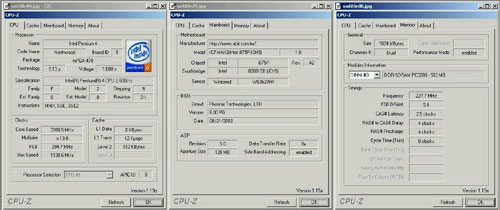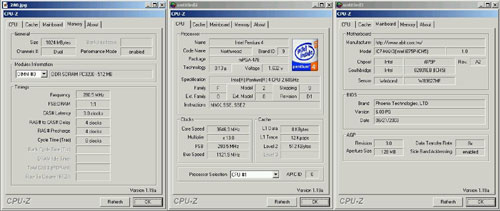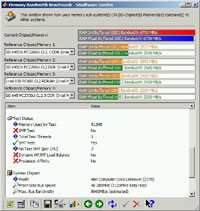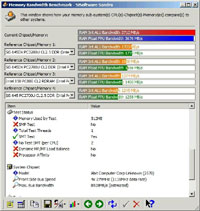|
|
|
|
|
ABIT IC7-MAX3 i875P Motherboard |
|
Join the community - in the OCAU Forums!
|
Overclocking, Pricing, Conclusions
OVERCLOCKING RESULTS
When the IC7 was launched in May 2003 DDR 400 was the fastest memory available. DDR 400 modules can rarely exceed a frequency of 250 to 260 MHz. With the introduction of DDR 500 in summer 2003, which can be in extreme cases overclocked to 300 MHz and more, some users suddenly realized that their IC7 would not allow them to exceed 255 MHz whatever latency or voltage setting they applied. We experienced the same phenomenon when we tested A-DATA DDR 500 memory on an IC7-G as shown in our test report here. Modules with 256 MB were running at 283 MHz on the P4C800-E, but the IC7 did not allow for more than 255 MHz. Whatever voltage or latency setting we tried: the IC7 did not boot above 255 MHz. The same happened initially with our test Max 3 using BIOS version 11. It took ABIT some time to fix this issue with new BIOS releases. However, we can confirm that ABIT did even more than just fixing the 255 MHz limitation issue.
The pair of 512 MB A-DATA DDR modules we used in this test were good for a maximum of 273 MHz on the P4C800-E. The same pair of modules made it to 280 MHz in 3-4-4-5 and a voltage of 2.65 on the Max 3. That is an outstanding result. We found that the Max 3 became unstable above 275 MHz and would not boot at 280 MHz when the memory timings were set to “SPD”. When “SPD“ is selected the memory is automatically set to its programmed default timings, being CAS 3-4-4-8 on our A-DATA DDR 500. These are the most conservative timings possible on 875P boards. The strange thing is that only when we selected “Manual” and set these timings manually the Max 3 would boot at 280 MHz. That’s odd, because in both cases the memory timings are supposed to be identical, the difference only being that in the first case they are set automatically and in the second case manually. Maybe this phenomenon is only related to the 12.0 beta BIOS or the specific RAM we used. We recommend users to try this out when they run into problems overclocking their RAM above 275 MHz on the Max 3.

Maximum CPU Overclock

Maximum RAM Overclock
We could run the 2600 “C” (13 x 200 MHz) on all 4 test boards at 13 x 250 MHz = 3250 MHz at CPU default voltage of 1.525 volt. The CPU was running 100% stable at this speed. It seems that 600~700 MHz overclocking headroom are almost guaranteed for the current “C” Pentium 4. Looking at that increasing yield we observed with Pentium 4 “B” over their production lifecycle we can expect that the “C’ might be even get better than this. We then tried to find the maximum frequency for our Pentium 4 2.6 GHz on the Max 3. Some IC7 users are reporting that DISABLING “Read Delay Adjust” and “Command per Clock” in the BIOS section “Advanced Chipset Features” does improve system stability when overclocking. We tried this but did not observe any difference. It might be related to the RAM we were using, and we recommend that IC7 users check it out nonetheless when overclocking their boards. Our 2 x 512 MB DDR 500 modules were apparently maxing out 280 MHz. Assuming and hoping that the CPU would go higher than 13 x 280 MHz = 3650 MHz we scaled back the memory frequency by choosing the 5:4 CPU to RAM divider. But to our dismay we found that the Max 3 simply would not boot above 270 MHz in 5:4. This is surprising, because at 5:4 the memory would run at a much lower frequency than the already achieved 280 MHz in 1:1. This problem could be overcome in the same way as above described: Setting the memory in “Advance Chipset Features” to “Manual” and selecting manually CAS 2.5-4-4-8 allowed us to run the system in 5:4 above 270 MHz. We passed 280 MHz this way and by increasing the CPU voltage to 1.68 volt we finally reached 13 x 285 = 3705 MHz, which is 1100 MHz faster than the default CPU frequency. We regard this result achieved with an air-cooled system as quite satisfactory. Running 2 x 512 MB modules at 280 MHz at 2.65 volt and an 1100 MHz overclocking headroom for the CPU are convincing evidence that the Max 3 has great overclocking potential. Nonetheless we have the feeling that the Max 3 is currently held back by the BIOS. Our “SPD” observations show that the BIOS version 12.0 needs further development.
 
Maximum buffered (left) and unbuffered (right) bandwidth
A word regarding CPU temperature: The Max 3 BIOS is reporting the CPU temperature between 10~13 Cº higher than with the ASUS P4C800-E. With an ambient temperature of 27Cº the Max 3 BIOS told us that the CPU was running at 49 Cº when idling. The P4C800-E showed us the same CPU in the same environment running at 39 Cº. That is quite a difference, but probably both readings are wrong. Touching the base of the heatsink gave us the impression that this CPU was operating at the same temperature on both boards. Many ABIT users are complaining about the apparently too high temperature readings on newer ABIT boards. ABIT has explained their position here. This is all fine with us, because we anyway don’t trust in BIOS temperature readings. Following ABIT’s explanation the BIOS temperature is “calculated” by a formula and not actually measured. Touching the base of the heatsink with an “experienced” finger is probably a more reliable way to take them. The bottom line is: The Max 3 BIOS shows higher CPU temperatures than other 875P boards, but there is nothing to worry about.
PRICING
The Max 3 is one of the most expensive 875P desktop mainboards. At the time of the market launch it was around 220 USD at Newegg, 400 AUD in Australia and 200 Euro in Europe. Stripped down entry-level 865PE boards are available for half the Max 3 price. Probably the price will go down a little over the next weeks, but the Max 3 will remain one of the most expensive 875 boards. Those who question this pricing should consider the value of the Max 3 hardware features. They become apparent when the Max 3 is compared with the only 10% cheaper ASUS P4P800-E. Consider what the Max 3 has, that the P4C800-E lacks:- 4-phase power regulation
- Active MCH cooling with high-performance HSF
- 4-channel SATA Raid controller
- Secure IDE
- 2 Rounded PATA cables
The 4-channel SATA RAID controller and Secure IDE together have a retail value of around 120 USD - that’s over half of the Max 3 price. There is no question: The Max 3 offers excellent value for money, if you can make use of the many features. Those who don’t care about these features are better served with a much cheaper and similar performing 865PE board.
CONCLUSIONS
ABIT’s IC7 Max 3 is oozing quality from every angle. It performs and overclocks on par or even better than major competitors. The Max 3 comes with several unique hardware features like the ingenious OTES cooling system, harddisk encryption and a 4-channel SATA RAID controller. Some of these features are for the first time implemented on a desktop motherboard and ABIT has to be applauded for releasing another highly innovative product into the market after the IT7. Those who have the Max 3 on their shortlist for an upgrade should not waver: this motherboard is an engineering masterpiece and worth every cent it costs you.
Altech Computers distribute ABIT products in Australia.
|
|
Advertisement:
All original content copyright James Rolfe.
All rights reserved. No reproduction allowed without written permission.
Interested in advertising on OCAU? Contact us for info.
|

|


